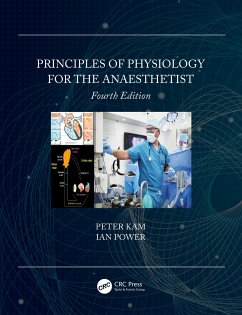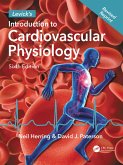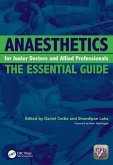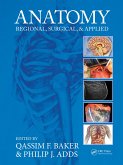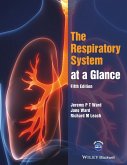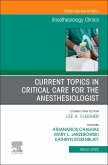Peter Kam (University of Sydney, St Leonards, NSW, Australia), Ian Power (Professor Emeritus, The University of Edinburgh, UK)
Principles of Physiology for the Anaesthetist
Peter Kam (University of Sydney, St Leonards, NSW, Australia), Ian Power (Professor Emeritus, The University of Edinburgh, UK)
Principles of Physiology for the Anaesthetist
- Broschiertes Buch
- Merkliste
- Auf die Merkliste
- Bewerten Bewerten
- Teilen
- Produkt teilen
- Produkterinnerung
- Produkterinnerung
This book provides readers with an anaesthesia-focused alternative to general physiology textbooks. The new edition has been reorganised with the trainee anaesthesist in mind, into shorter bite-sized chapters ideal for exam revision.
Andere Kunden interessierten sich auch für
![Knight's Forensic Pathology Knight's Forensic Pathology]() Pekka Saukko (Dr.med.univ. (Vienna) , Dr.Med.Sci., Specialist in ForKnight's Forensic Pathology429,99 €
Pekka Saukko (Dr.med.univ. (Vienna) , Dr.Med.Sci., Specialist in ForKnight's Forensic Pathology429,99 €![Levick's Introduction to Cardiovascular Physiology Levick's Introduction to Cardiovascular Physiology]() Neil Herring (Associate Professor & Univer BHF Intermediate FellowLevick's Introduction to Cardiovascular Physiology65,99 €
Neil Herring (Associate Professor & Univer BHF Intermediate FellowLevick's Introduction to Cardiovascular Physiology65,99 €![Anaesthetics for Junior Doctors and Allied Professionals Anaesthetics for Junior Doctors and Allied Professionals]() Daniel CottleAnaesthetics for Junior Doctors and Allied Professionals66,99 €
Daniel CottleAnaesthetics for Junior Doctors and Allied Professionals66,99 €![Anatomy Anatomy]() Anatomy64,99 €
Anatomy64,99 €![The Respiratory System at a Glance The Respiratory System at a Glance]() Jeremy P. T. Ward (London King's College)The Respiratory System at a Glance45,99 €
Jeremy P. T. Ward (London King's College)The Respiratory System at a Glance45,99 €![Current Topics in Critical Care for the Anesthesiologist, an Issue of Anesthesiology Clinics Current Topics in Critical Care for the Anesthesiologist, an Issue of Anesthesiology Clinics]() Current Topics in Critical Care for the Anesthesiologist, an Issue of Anesthesiology Clinics136,99 €
Current Topics in Critical Care for the Anesthesiologist, an Issue of Anesthesiology Clinics136,99 €![Anaesthesia and the Practice of Medicine: Historical Perspectives Anaesthesia and the Practice of Medicine: Historical Perspectives]() Keith SykesAnaesthesia and the Practice of Medicine: Historical Perspectives43,99 €
Keith SykesAnaesthesia and the Practice of Medicine: Historical Perspectives43,99 €-
-
-
This book provides readers with an anaesthesia-focused alternative to general physiology textbooks. The new edition has been reorganised with the trainee anaesthesist in mind, into shorter bite-sized chapters ideal for exam revision.
Hinweis: Dieser Artikel kann nur an eine deutsche Lieferadresse ausgeliefert werden.
Hinweis: Dieser Artikel kann nur an eine deutsche Lieferadresse ausgeliefert werden.
Produktdetails
- Produktdetails
- Verlag: Taylor & Francis Ltd
- 4 ed
- Seitenzahl: 511
- Erscheinungstermin: 21. September 2020
- Englisch
- Abmessung: 246mm x 193mm x 30mm
- Gewicht: 1262g
- ISBN-13: 9780367202293
- ISBN-10: 0367202298
- Artikelnr.: 59791410
- Herstellerkennzeichnung
- Libri GmbH
- Europaallee 1
- 36244 Bad Hersfeld
- gpsr@libri.de
- Verlag: Taylor & Francis Ltd
- 4 ed
- Seitenzahl: 511
- Erscheinungstermin: 21. September 2020
- Englisch
- Abmessung: 246mm x 193mm x 30mm
- Gewicht: 1262g
- ISBN-13: 9780367202293
- ISBN-10: 0367202298
- Artikelnr.: 59791410
- Herstellerkennzeichnung
- Libri GmbH
- Europaallee 1
- 36244 Bad Hersfeld
- gpsr@libri.de
Peter Kam MBBS, MD, FRCA, FANCZA, FFARCSI, FHKCA (Hon) Nuffield Professor of Anaesthetics, Sydney Medical School, University of Sydney Royal Prince Alfred Hospital Camperdown, Australia Ian Power BSc (Hon), MD, FRCA, FFPMANZCA, FANZCA, FRCSEd, FRCP Edin, FFPFRCA Emeritus Professor at the University of Edinburgh, Edinburgh, United Kingdom
Preface to the first edition. Preface to the second edition. Preface to the
third edition. Preface to fourth edition. Acknowledgements. Authors.
Contributors. Basic Cell Physiology. Cell Components and Function.
Physiology of Excitable Cells. Neurotransmitters and Receptors, Ion
Channels, G Proteins and Second Messengers. Physiology of the Nervous
System. Neuronal Function. Blood-Brain Barrier and Cerebrospinal Fluid
(CSF). Cerebral Circulation. Spinal Cord: Anatomical and Physiological
Features. Sensory System. Motor Function and Control: Descending Tracts.
Autonomic Nervous System. Consciousness, EEG, Sleep and Emotions. Muscle
Physiology. Striated Muscles: Skeletal and Cardiac Muscles. Muscle
Spindles, Golgi Tendon Organs and Spinal Reflexes. Smooth Muscle.
Respiratory Physiology. Functions of the Respiratory System. Mechanical
Properties of the Lungs. Gas Exchange in the Lungs. Carriage of Oxygen in
Blood. Carbon Dioxide Carriage in Blood. Pulmonary Circulation. Control of
Ventilation. Applied Respiratory Physiology. Cardiovascular Physiology.
Functions of the Cardiovascular System. Electrical Properties of the Heart.
Mechanical Events of the Cardiac Cycle. Pressure-Volume Loop of the Left
Ventricle. Physical Factors Governing Blood Flow Through Vessels. The
Systemic Circulation. Microcirculation. Venous Return and Vascular
Function. Regulation of Arterial Blood Pressure. Integrated Cardiovascular
Responses. Gastrointestinal Physiology. Saliva, Swallowing, and Lower
Oesophageal Sphincter. Stomach: Gastric Secretions, Motility, Digestion and
Vomiting. The Small Intestine: Secretions, Digestion and Motility. The
Large Intestine. Liver Physiology. Functions of the Liver. Liver Blood
Flow. Liver Function Tests and Physiological Features of Liver Failure.
Renal Physiology. Functions of the Kidneys and Functional Anatomy. Renal
Blood Flow. Glomerular Filtration. Tubular Function. The Loop of Henle and
Production of Concentrated Urine: Counter-Current Mechanisms of the Kidney.
Overview of Renal Control of Acid-Base Balance. Applied Physiology: Renal
Failure. Acid-Base Physiology. Basic Concepts of Acid-Base Physiology.
Compensatory Mechanisms in Acid-Base Disorders. Clinical Aspects of
Acid-Base Control. Anion Gap and Stewart's Strong Ion Difference.
Physiology of Blood. Cellular Components of Blood. Plasma: The Non-Cellular
Components of Blood. Haemostasis. Blood Transfusion. Physiology of the
Immune System. Immune System and Innate Immunity. Acquired Immunity.
Cytokines. Hypersensitivity. Endocrine Physiology. General Aspects of
Endocrine Physiology. Pituitary Gland. Hormones of the Pancreas. Thyroid
Hormones and Calcium Metabolism. Hormones of the Adrenal Gland.
Erythropoietin, Atrial Natriuretic Peptide and Sex Hormones. Metabolism,
Nutrition, Exercise and Temperature Regulation. Metabolism. Nutrition.
Exercise Physiology. Temperature Regulation. Physiology of Pain.
Peripheral Mechanisms of Pain. Central Modulation of Pain. Pain
Sensitization. Physiology of Pregnancy, Placenta, Neonate, Ageing and
Obesity. Physiology of Pregnancy. Physiology of the Placenta. Physiology of
the Neonate. Physiology of Ageing. Physiology of Obesity. Special
Environments. Physiology Related to Special Environments. Further reading.
Index.
third edition. Preface to fourth edition. Acknowledgements. Authors.
Contributors. Basic Cell Physiology. Cell Components and Function.
Physiology of Excitable Cells. Neurotransmitters and Receptors, Ion
Channels, G Proteins and Second Messengers. Physiology of the Nervous
System. Neuronal Function. Blood-Brain Barrier and Cerebrospinal Fluid
(CSF). Cerebral Circulation. Spinal Cord: Anatomical and Physiological
Features. Sensory System. Motor Function and Control: Descending Tracts.
Autonomic Nervous System. Consciousness, EEG, Sleep and Emotions. Muscle
Physiology. Striated Muscles: Skeletal and Cardiac Muscles. Muscle
Spindles, Golgi Tendon Organs and Spinal Reflexes. Smooth Muscle.
Respiratory Physiology. Functions of the Respiratory System. Mechanical
Properties of the Lungs. Gas Exchange in the Lungs. Carriage of Oxygen in
Blood. Carbon Dioxide Carriage in Blood. Pulmonary Circulation. Control of
Ventilation. Applied Respiratory Physiology. Cardiovascular Physiology.
Functions of the Cardiovascular System. Electrical Properties of the Heart.
Mechanical Events of the Cardiac Cycle. Pressure-Volume Loop of the Left
Ventricle. Physical Factors Governing Blood Flow Through Vessels. The
Systemic Circulation. Microcirculation. Venous Return and Vascular
Function. Regulation of Arterial Blood Pressure. Integrated Cardiovascular
Responses. Gastrointestinal Physiology. Saliva, Swallowing, and Lower
Oesophageal Sphincter. Stomach: Gastric Secretions, Motility, Digestion and
Vomiting. The Small Intestine: Secretions, Digestion and Motility. The
Large Intestine. Liver Physiology. Functions of the Liver. Liver Blood
Flow. Liver Function Tests and Physiological Features of Liver Failure.
Renal Physiology. Functions of the Kidneys and Functional Anatomy. Renal
Blood Flow. Glomerular Filtration. Tubular Function. The Loop of Henle and
Production of Concentrated Urine: Counter-Current Mechanisms of the Kidney.
Overview of Renal Control of Acid-Base Balance. Applied Physiology: Renal
Failure. Acid-Base Physiology. Basic Concepts of Acid-Base Physiology.
Compensatory Mechanisms in Acid-Base Disorders. Clinical Aspects of
Acid-Base Control. Anion Gap and Stewart's Strong Ion Difference.
Physiology of Blood. Cellular Components of Blood. Plasma: The Non-Cellular
Components of Blood. Haemostasis. Blood Transfusion. Physiology of the
Immune System. Immune System and Innate Immunity. Acquired Immunity.
Cytokines. Hypersensitivity. Endocrine Physiology. General Aspects of
Endocrine Physiology. Pituitary Gland. Hormones of the Pancreas. Thyroid
Hormones and Calcium Metabolism. Hormones of the Adrenal Gland.
Erythropoietin, Atrial Natriuretic Peptide and Sex Hormones. Metabolism,
Nutrition, Exercise and Temperature Regulation. Metabolism. Nutrition.
Exercise Physiology. Temperature Regulation. Physiology of Pain.
Peripheral Mechanisms of Pain. Central Modulation of Pain. Pain
Sensitization. Physiology of Pregnancy, Placenta, Neonate, Ageing and
Obesity. Physiology of Pregnancy. Physiology of the Placenta. Physiology of
the Neonate. Physiology of Ageing. Physiology of Obesity. Special
Environments. Physiology Related to Special Environments. Further reading.
Index.
Preface to the first edition. Preface to the second edition. Preface to the
third edition. Preface to fourth edition. Acknowledgements. Authors.
Contributors. Basic Cell Physiology. Cell Components and Function.
Physiology of Excitable Cells. Neurotransmitters and Receptors, Ion
Channels, G Proteins and Second Messengers. Physiology of the Nervous
System. Neuronal Function. Blood-Brain Barrier and Cerebrospinal Fluid
(CSF). Cerebral Circulation. Spinal Cord: Anatomical and Physiological
Features. Sensory System. Motor Function and Control: Descending Tracts.
Autonomic Nervous System. Consciousness, EEG, Sleep and Emotions. Muscle
Physiology. Striated Muscles: Skeletal and Cardiac Muscles. Muscle
Spindles, Golgi Tendon Organs and Spinal Reflexes. Smooth Muscle.
Respiratory Physiology. Functions of the Respiratory System. Mechanical
Properties of the Lungs. Gas Exchange in the Lungs. Carriage of Oxygen in
Blood. Carbon Dioxide Carriage in Blood. Pulmonary Circulation. Control of
Ventilation. Applied Respiratory Physiology. Cardiovascular Physiology.
Functions of the Cardiovascular System. Electrical Properties of the Heart.
Mechanical Events of the Cardiac Cycle. Pressure-Volume Loop of the Left
Ventricle. Physical Factors Governing Blood Flow Through Vessels. The
Systemic Circulation. Microcirculation. Venous Return and Vascular
Function. Regulation of Arterial Blood Pressure. Integrated Cardiovascular
Responses. Gastrointestinal Physiology. Saliva, Swallowing, and Lower
Oesophageal Sphincter. Stomach: Gastric Secretions, Motility, Digestion and
Vomiting. The Small Intestine: Secretions, Digestion and Motility. The
Large Intestine. Liver Physiology. Functions of the Liver. Liver Blood
Flow. Liver Function Tests and Physiological Features of Liver Failure.
Renal Physiology. Functions of the Kidneys and Functional Anatomy. Renal
Blood Flow. Glomerular Filtration. Tubular Function. The Loop of Henle and
Production of Concentrated Urine: Counter-Current Mechanisms of the Kidney.
Overview of Renal Control of Acid-Base Balance. Applied Physiology: Renal
Failure. Acid-Base Physiology. Basic Concepts of Acid-Base Physiology.
Compensatory Mechanisms in Acid-Base Disorders. Clinical Aspects of
Acid-Base Control. Anion Gap and Stewart's Strong Ion Difference.
Physiology of Blood. Cellular Components of Blood. Plasma: The Non-Cellular
Components of Blood. Haemostasis. Blood Transfusion. Physiology of the
Immune System. Immune System and Innate Immunity. Acquired Immunity.
Cytokines. Hypersensitivity. Endocrine Physiology. General Aspects of
Endocrine Physiology. Pituitary Gland. Hormones of the Pancreas. Thyroid
Hormones and Calcium Metabolism. Hormones of the Adrenal Gland.
Erythropoietin, Atrial Natriuretic Peptide and Sex Hormones. Metabolism,
Nutrition, Exercise and Temperature Regulation. Metabolism. Nutrition.
Exercise Physiology. Temperature Regulation. Physiology of Pain.
Peripheral Mechanisms of Pain. Central Modulation of Pain. Pain
Sensitization. Physiology of Pregnancy, Placenta, Neonate, Ageing and
Obesity. Physiology of Pregnancy. Physiology of the Placenta. Physiology of
the Neonate. Physiology of Ageing. Physiology of Obesity. Special
Environments. Physiology Related to Special Environments. Further reading.
Index.
third edition. Preface to fourth edition. Acknowledgements. Authors.
Contributors. Basic Cell Physiology. Cell Components and Function.
Physiology of Excitable Cells. Neurotransmitters and Receptors, Ion
Channels, G Proteins and Second Messengers. Physiology of the Nervous
System. Neuronal Function. Blood-Brain Barrier and Cerebrospinal Fluid
(CSF). Cerebral Circulation. Spinal Cord: Anatomical and Physiological
Features. Sensory System. Motor Function and Control: Descending Tracts.
Autonomic Nervous System. Consciousness, EEG, Sleep and Emotions. Muscle
Physiology. Striated Muscles: Skeletal and Cardiac Muscles. Muscle
Spindles, Golgi Tendon Organs and Spinal Reflexes. Smooth Muscle.
Respiratory Physiology. Functions of the Respiratory System. Mechanical
Properties of the Lungs. Gas Exchange in the Lungs. Carriage of Oxygen in
Blood. Carbon Dioxide Carriage in Blood. Pulmonary Circulation. Control of
Ventilation. Applied Respiratory Physiology. Cardiovascular Physiology.
Functions of the Cardiovascular System. Electrical Properties of the Heart.
Mechanical Events of the Cardiac Cycle. Pressure-Volume Loop of the Left
Ventricle. Physical Factors Governing Blood Flow Through Vessels. The
Systemic Circulation. Microcirculation. Venous Return and Vascular
Function. Regulation of Arterial Blood Pressure. Integrated Cardiovascular
Responses. Gastrointestinal Physiology. Saliva, Swallowing, and Lower
Oesophageal Sphincter. Stomach: Gastric Secretions, Motility, Digestion and
Vomiting. The Small Intestine: Secretions, Digestion and Motility. The
Large Intestine. Liver Physiology. Functions of the Liver. Liver Blood
Flow. Liver Function Tests and Physiological Features of Liver Failure.
Renal Physiology. Functions of the Kidneys and Functional Anatomy. Renal
Blood Flow. Glomerular Filtration. Tubular Function. The Loop of Henle and
Production of Concentrated Urine: Counter-Current Mechanisms of the Kidney.
Overview of Renal Control of Acid-Base Balance. Applied Physiology: Renal
Failure. Acid-Base Physiology. Basic Concepts of Acid-Base Physiology.
Compensatory Mechanisms in Acid-Base Disorders. Clinical Aspects of
Acid-Base Control. Anion Gap and Stewart's Strong Ion Difference.
Physiology of Blood. Cellular Components of Blood. Plasma: The Non-Cellular
Components of Blood. Haemostasis. Blood Transfusion. Physiology of the
Immune System. Immune System and Innate Immunity. Acquired Immunity.
Cytokines. Hypersensitivity. Endocrine Physiology. General Aspects of
Endocrine Physiology. Pituitary Gland. Hormones of the Pancreas. Thyroid
Hormones and Calcium Metabolism. Hormones of the Adrenal Gland.
Erythropoietin, Atrial Natriuretic Peptide and Sex Hormones. Metabolism,
Nutrition, Exercise and Temperature Regulation. Metabolism. Nutrition.
Exercise Physiology. Temperature Regulation. Physiology of Pain.
Peripheral Mechanisms of Pain. Central Modulation of Pain. Pain
Sensitization. Physiology of Pregnancy, Placenta, Neonate, Ageing and
Obesity. Physiology of Pregnancy. Physiology of the Placenta. Physiology of
the Neonate. Physiology of Ageing. Physiology of Obesity. Special
Environments. Physiology Related to Special Environments. Further reading.
Index.

